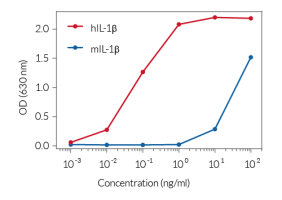Cholesterol Crystals
-
Cat.code:
tlrl-chol
- Documents
ABOUT
NLRP3 inflammasome Inducer - Cholesterol Crystals
Cholesterol crystals are provided ready-to-use to study NLRP3 inflammasome activation, validated using proprietary IL-1β reporter cells.
Cholesterol crystals are the hallmark of atherosclerosis, a condition where plaque builds up in arteries, increasing the risk of heart attacks and strokes [1]. They act as key danger-associated molecular patterns (DAMPs) able to stimulate the NLRP3 inflammasome-dependent induction of pro-inflammatory cytokines, namely interleukin 1β (IL-1β) and IL-18 [1]. This inflammatory response contributes to the progression of atherosclerosis and other life-threatening pathologies, such as Type 2 Diabetes and cancer [1].
Cholesterol crystals for in vitro experiments are typically prepared by precipitating ultrapure cholesterol in 1-propanol, which can lead to significant batch-to-batch variation in potency.
InvivoGen's ready-to-use cholesterol crystals are produced in a controlled environment and functionally tested to ensure consistency. Designed for in vitro use in cell culture, their biological activity has been validated using InvivoGen's THP1-Null2 cells and HEK-Blue™ IL-1β cells (see figure).
Key features
- Potent inducer of the NLRP3 inflammasome
- Each lot is functionally tested for robust and reproducible results
![]() Read our review on the NLRP3 inflammasome.
Read our review on the NLRP3 inflammasome.
![]() Download our Practical guide on Inflammasomes.
Download our Practical guide on Inflammasomes.
Reference:
1. Duewell P, et al., 2010. NLRP3 inflammasomes are required for atherogenesis and activated by cholesterol crystals. Nature. 464(7293):1357-611.
All products are for research use only, and not for human or veterinary use.
SPECIFICATIONS
Specifications
NLRP3
C27H46O
20 mg/ml in sterile water
Not soluble
Negative (tested using EndotoxDetect™ assay)
Induction of NLRP3 inflammasome response
NLRP3 activation
Each lot is functionally tested and validated.
CONTENTS
Contents
-
Product:Cholesterol Crystals
-
Cat code:tlrl-chol
-
Quantity:20 mg
Shipping & Storage
- Shipping method: Room temperature
- -20 °C
- Avoid repeated freeze-thaw cycles
Storage:
Caution:
Details
Atherosclerosis
Atherosclerosis is a progressive chronic disease characterized by the accumulation of lipid, and cholesterol crystals (CCs), and infiltration of immune cells, such as monocytes, macrophages, T cells, and neutrophils [1]. During atherogenesis, cholesterol precipitates and crystallizes into CCs in the arterial wall. Phagocytosis of these sharp-edged CCs causes lysosomal damage, sensed by the NACHT, LRR, and PYD domains-containing protein 3 (NLRP3) inflammasome. This leads to the release of pro-inflammatory cytokines (e.g. interleukin 1β (IL-1β), which is associated with disease severity and outcome [1].
NLRP3
The NLRP3 inflammasome is an intracellular multi-protein complex that plays a central role in innate immunity. It is activated by a two-step process. A first signal (‘priming’) is provided by pathogen-associated molecular patterns (PAMPs) or cytokines. It allows the transcriptional upregulation of key inflammasome actors and the post-translational modification of NLRP3. A wide array of stimuli including microbial toxins, endogenous molecules or crystalline substances provides the second signal (‘activation’). The current paradigm is that NLRP3 does not bind directly to these molecules. Rather it senses downstream cytosolic stress signals such as K+ efflux. This triggers inflammasome multimerization and pro-caspase-1 maturation. Proximity-induced autolytic activation of caspase-1 leads to the formation of gasdermin D (GSDMD) pores at the cell surface, allowing IL-1β/IL-18 and alarmin secretion, and ultimately, pyroptosis [3,4].
References:
1. Niyonzima N, et al., 2020. Cholesterol crystals use complement to increase NLRP3 signaling pathways in coronary and carotid atherosclerosis. EBioMedicine.;60:102985.
2. Pelegrin P, & Surprenant A., 2007. Pannexin-1 couples to maitotoxin- and nigericin-induced interleukin-1beta release through a dye uptake-independent pathway. J Biol Chem. 282(4):2386-94.
3. Swanson K.V. et al., 2019. The NLRP3 inflammasome: molecular activation and regulation to therapeutics. Nat. Rev. Immunol. 19:477.
4. Groslambert M. & Py B. 2018. Spotlight on the NLRP3 inflammasome pathway. J. Inflamm. Res. 11:359.
DOCUMENTS
Documents
Technical Data Sheet
Validation Data Sheet
Safety Data Sheet
Certificate of analysis
Need a CoA ?







